 |
 |
Environmental Status
Marine environment |
Water quality
For coastal management purposes, Korea divides its coastal area into 10 regions. Since 1990, water quality (COD) values have been relatively stable with the indication of a slight improvement. Within Korea, water quality values (in comparison to their water quality standard) can be generally classified into Grade II (under 2mg/L). |
 |
Marine pollution
| Table 1 Number of red tide occurrences and economic loss |
Year
|
No. of occurrences |
Economic loss
(Hundred million Won) |
| 1992 |
27
|
194 |
| 1993 |
38 |
84 |
| 1994 |
29 |
3 |
| 1995 |
65 |
765 |
| 1996 |
61 |
21 |
|
In Korea, the first recorded incidence of a red tide was in October 1961 at Chindong Bay. Then in the 1970s, red tides started to occur in and around Chinhae Bay and after 1981 red tides were recorded across wider areas with increased durations. In 1995, a large scale red tide occurred along the Gyeongsangnam-do coast, southern coast and southeast coast, causing extensive damage to fisheries (Table 1).
|
 |
Status of coastline
The sea around Korea is relatively shallow with approximately 77% of the sea area located within the continental shelf. Extensive areas of tidal flats are found along the west and south coast accounting for 3% of the national land area. |
 |
| River environment |
Water quality
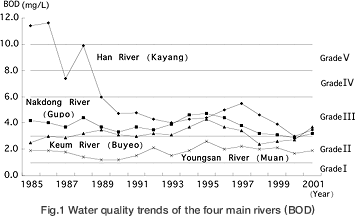 Since the 1950s, as a consequence of rapid development, Seoul has faced various urban environmental problems. For example, water quality in the Han River, which flows through the city, slowly became highly polluted and in the late 1980s BOD values exceeded the Grade V water quality values* (10mg / L). After the enactment of Water Quality Preservation Act in 1990, stricter emission standards and other regulations were implemented, consequently water quality has gradually improved and currently the water quality of the Han River is classified as Grade III. The water quality of other rivers has remained stable since 1985, with the Youngsan River classified as Grade II and the Nakdong and Keum Rivers as Grade III (Fig 1). Since the 1950s, as a consequence of rapid development, Seoul has faced various urban environmental problems. For example, water quality in the Han River, which flows through the city, slowly became highly polluted and in the late 1980s BOD values exceeded the Grade V water quality values* (10mg / L). After the enactment of Water Quality Preservation Act in 1990, stricter emission standards and other regulations were implemented, consequently water quality has gradually improved and currently the water quality of the Han River is classified as Grade III. The water quality of other rivers has remained stable since 1985, with the Youngsan River classified as Grade II and the Nakdong and Keum Rivers as Grade III (Fig 1). |
| * : Depending on water use / conservation objectives, water quality is classified into 5 grades, with corresponding standard values. For BOD, standard values of 1,3,,6,8,10mg / L are set for Grades I - V respectively. |
 |
Status of sewage treatment
As of 1998 there were 114 sewage treatment plants (with a treatment capacity of 16.62 million tons / day), accounting for a 66% supply rate. Secondary treatment (activated sludge method) is the most common treatment method.
Although sewage treatment facilities are well established in the urban areas such as Seoul, Kwangju and Taegu, rural areas are still behind with Chonnam’s supply rate at less than 11%. |
 |
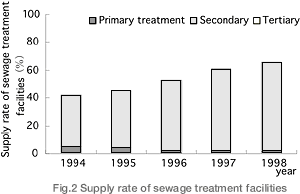 |
Table 2 Supply rate of sewage treatment
facilities in the Korean cities
(1998) |
Sewage system
supply rate (%) |
Sewage system
supply rate (%) |
| Whole Country 65.9% |
| 1 |
Seoul (98.9) |
9
|
Chungbuk (59.3) |
| 2 |
Kwangju (94.2) |
10 |
Kyongbuk (38.8) |
| 3 |
Taegu (90.6) |
11 |
Kangwon (36.7) |
| 4 |
Taejon (90.3)
|
12 |
Chonbuk (34.8) |
| 5 |
Inchon (85.5) |
13 |
Kyongnam (25.1) |
| 6 |
Kyonggi (70.5) |
14 |
Chungnam (22.9) |
| 7 |
Pusan (69.4) |
15 |
Ulsan (19.5) |
| 8 |
Cheju (61.8) |
16 |
Chonnam (10.9) |
|
|
 |
| Atmospheric environment |
Nitrogen oxides
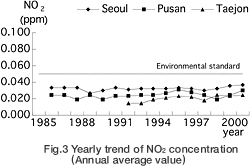 Although NO2 concentrations show a slight increase in some areas, values do not exceed the environmental standard (Fig. 3). Although NO2 concentrations show a slight increase in some areas, values do not exceed the environmental standard (Fig. 3). |
 |
Sulfur oxides
Until 1992, SO2 concentrations often exceeded the environmental standard. However, after the enactment of the Air Quality Preservation Act in 1990, monitoring of air quality was reinforced and gradually SO2 concentrations began to decline to their present level (Fig. 4). |
 |
Suspended particulate matter (PM-10)
PM-10 concentrations have been declining in Pusan and Daejeon since 1995, however the concentration level in Seoul indicates an increasing trend (Fig. 5). |
 |
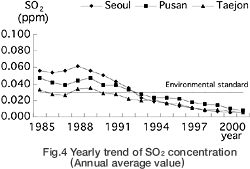 |
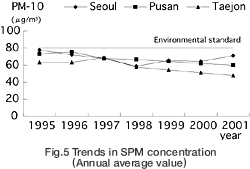 |
 |
Environmental Administration
Korea |
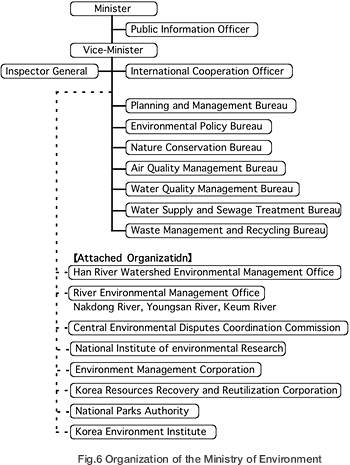 Administrative structure Administrative structure
The Ministry of Environment plays a central role in the creation and implementation of environmental policy in Korea. Its main tasks involve the enactment and amendment of environmental laws and regulations, the preparation of long-term and short-term comprehensive plans for environmental protection, establishment of regulations and standards and the promotion of international cooperation in environmental conservation.
Other related administrations include The Ministry of Construction and Transport and The Ministry of Fishery and Marine Resources, which are assigned with activities such as river management and marine pollution control. |
 |
Environmental laws and regulations
“The Environmental Policy Act”, enacted in 1990 is a basic environmental law, which provides the aims and directions of the environmental policy in regard to the environment of Korea. It covers aspects such as the polluter-pays-principle, issues concerning the establishment and enforcement of long-term comprehensive plans for environmental conservation and a principle of the polluter’s absolute liability and joint liability of the enterpriser to be accountable for any damages.
Under the Environmental Policy Act, various individual laws concerning the protection of the air, water and soil quality laws are enacted (Table 3). |
| Table 3 Major environmental laws |
| Category |
Laws |
| Basic Law |
- Environmental Policy Act (1999.12.31) |
Air
Noise and
Vibration |
- Air Quality Preservation Act (1999.4.15)
- Air Quality Management Act for Underground Living Spaces
(1996.12.30)
- Noise and Vibration Control Act (1999.2.8)
|
| Water |
- Water Quality Preservation Act (2000.1.21)
- Act Relating to Treatment of Sewage, Nightsoil and Livestock Wastewater (1999.2.8)
- Sewage Treatment Act (1999.2.8)
- Act Relating to Water Resource Quality Improvement and Local
Resident Support in the Han River Watershed (1999.2.8) |
| Soil |
- Soil Environment Preservation Act (1999.2.8) |
Waste
Recycle |
- Waste Management Act (1999.12.31)
- Act Relating to Promotion of Resource Saving and Reutilization
(1999.2.8)
- Act for Promotion of Waste Treatment Facilities and Local
Communities (1999.2.8)
- Act Relating to the Transboundary Movement of Waste and its
Disposal (1999.2.8)
|
Natural
Resources
|
- Natural Environment Conservation Act (1999.2.8)
- Special Act Relating to the Conservation of Island Ecosystems
such as Tokdo, etc. (1997.12.13)
- Natural Parks Act (1999.2.8)
- Wetlands Preservation Act (1999.2.8)
- Act Relating to Wildlife Protection and Hunting (1999.3.31)
|
|
|
 |
| Table 4 Major environmental laws |
| Category |
Laws |
| Others |
[Impact Assessment]
- Environmental Impact Assessment Act (1992.2.8)
[Chemical substances]
- Toxic Chemicals Control Act (1999.2.8)
[Drinking water source]
- Water Supply and Waterworks Act (1999.2.8)
- Drinking Water Management Act (2000.1.7)
[Others]
- Act Relating to Support and Development of Environmental
Technologies (2000.2.3)
- Special Act Relating to the Control of Environmental Crimes (1999.12.31)
- Environmental Dispute Settlement Act (1997.8.28)
- Environmental Improvement Account Act (1996.12.30)
- Act Relating to Environmental Improvement Charges (1999.2.8)
- Environmental Management Corporation Act (1993.12.27)
- Korean Resources Recovery and Reutilization Corporation Act (1993.12.27)
- Act Relating to Establishment and Operation of the Metropolitan
Area Landfill Management Corporations (2000.1.21)
- Environmental Impact Assessment Act (1999.2.8)
|
|
Note : date inside the parenthesis is either the enactment date or the last revised date
There are more than 50 different environmental laws governed by other Ministries and more than 15 relevant agencies / sections that are not mentioned in the above list.
|
|
 |
 |

